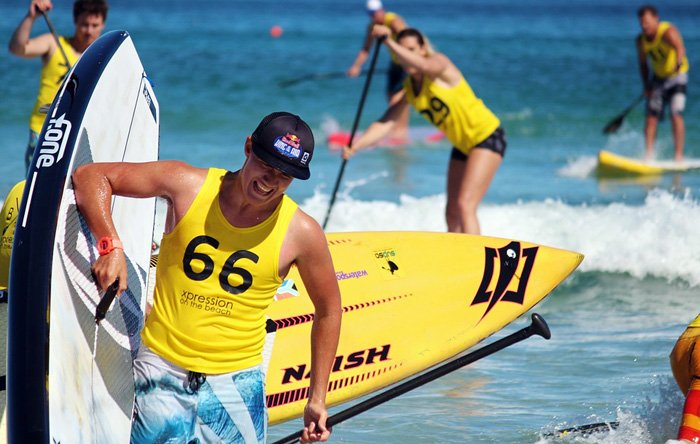Paddle Boarding: A Sport For The Ages

With summer temperatures beating at 90 degrees Fahrenheit, you might be tempted to stay indoors and enjoy a cool breeze. But despite all of the comforts that indoor living has to offer, it can often present some dangers: staying inside for too long can lead to heat exhaustion and more, which is why many people choose to venture outdoors during their summer breaks. In this article, you’ll learn about the benefits of paddle boarding as well as how it can get you fit without having to break a sweat!
Introducing paddle boarding, a sport that is sure to excite any age group. Paddle boarding is a great way to get exercise, have some fun and see some amazing views. It’s not only easy on the joints, but it’s also a great way to connect with nature. If you’re looking for a new adventure and want to stay active all summer long, paddle boarding should be at the top of your list.
History of Paddle Boarding
paddle boarding is a sport that has been around for centuries and is enjoyed by people of all ages. It started out as a way for people to get exercise, but it quickly evolved into a recreational activity with its own set of rules and etiquette.
Paddleboarding first appeared in the early 1800s as a means of transportation on rivers and lakes. At the time, it was mainly used by wealthy people who could afford to buy a boat. However, paddle boarding soon became popular with the general population, particularly in coastal areas where there are lots of lakes and rivers.
Paddleboarding first became an Olympic sport in 1992. At that time, only men competed in the event, but that changed in 2008 when women were allowed to compete. Today, both men and women can enjoy paddle boarding without having to worry about any restrictions or boundaries.
Despite its popularity, paddle boarding has always been controversial. Some people argue that it’s a dangerous activity because you have to rely on your skills and judgment while paddling. Others say that it’s an amazing way to spend an afternoon and experience different parts of nature without having to use any other type of transportation.
How to Standup Paddle Board (SUP)
If you’re looking for a great workout, paddle boarding may be the sport for you. Standing up paddle boarding is a great way to work your entire body and get some fresh air at the same time. Here’s how to standup paddle board:
1) Get yourself an adventure paddle board. There are many different styles and brands available so find one that fits your needs.
2) Get comfortable. Make sure you have enough clothing to cover your body because you will be sweating!
3) Find a good spot. Look for a spot where the water is calm and there are no waves.
4) Get ready! Stand with your feet hip-width apart, with the board in front of you about two feet off the ground. Take a deep breath and hold it as you lift your left leg behind you and place it on top of the board, then push off from the bottom with your right foot. Keep your balance as you move forward, using your left arm and hand to steer the board.
5) Enjoy the ride! Paddle Boarding is an exhilarating sport that can be enjoyed by both beginners and experienced paddlers alike!
Equipment and Safety
Paddle boarding is a sport that has been around for centuries and is enjoyed by people of all ages. In fact, paddle boarding may be one of the oldest sports on the planet.
The equipment you need to participate in paddle boarding is fairly simple. You will need a board, paddle, Lifejacket, and PFD (personal flotation device).
When choosing your paddle, make sure it is long enough to reach the water from your board. The blade should be stiff so that you can push the board forward and maintain control while paddling. Choosing the right size to paddle for your body size and skill level is also important. For more updates, visit: https://thehollynews.com
Before you even set out on the water, be sure to familiarize yourself with the safety precautions for paddle boarding. Always swim before you paddle, obey all safety signs, and watch for other boats and people in the water. Remember to take a picture of your first-time paddle boarding trip so that you can share it with friends!
How to Surf?
Surfing is one of the oldest and most popular sports in the world. It can be enjoyed by anyone, regardless of experience or skill level. All you need is a board, some water, and some sense of balance. Here are four tips for beginners to help them learn how to surf:
1. Start small. Don’t try to ride the biggest waves right away. Find smaller waves that are manageable and that you feel comfortable riding. You can also practice riding waves at the beach before heading out to more challenging waves.
2. Get a good board. A good board will make your surfing experience much more enjoyable. Make sure you find a board that is suited for your size, weight, and style of surfing. There are many different types of panels available on the market, so it’s important to find the one that best suits your needs.
3. Practice, practice, practice. Surfing isn’t about talent; it’s about practice. If you want to improve your surfing skills, make sure you spend time on the water practicing every day. If possible, find a group of friends who also want to improve their surfing skills and join a surf club or surf team. The more you practice, the better your surfing will become!
4. Expect to get cold. Being in and out of the water for hours on end can be a bit chilly, especially when it’s windy. If possible, bring a jacket with you when you go out to surf, or wear a wet vest so that your skin doesn’t get cold while you are surfing.
5. Don’t forget the sunscreen! Sunscreen is super important when surfing because it protects your skin from the sun’s harmful rays while having fun on the waves. Plus, you’ll feel protected from the wind and salt water spray as well!
The Pros and Cons of Standup Paddle Boarding
There are many benefits to paddle boarding, but it isn’t for everyone. Here are the pros and cons of paddle boarding:
PRO: It’s a great way to get a workout. Paddle boarding is a moderate-to-vigorous aerobic exercise that burns about 300 calories per hour.
CON: Paddleboarding can be dangerous if you’re not properly trained. If you fall off your board, you could end up in the water with little chance of survival.
PRO: The scenery is amazing. Standup paddle boarding lets you explore calm or flowing water at your own pace, and you can see some of the most stunning views in nature.
CON: If you’re new to paddle boarding, it can be hard to stay on your board. You need to have good balance and coordination, and learning to ride a board can take some time.
Tips for Beginners
If you’re thinking about getting into paddle boarding, there are a few things you need to know before you go.
1. Paddle boarding is not a sport for the faint of heart. It’s a physically demanding activity that can be dangerous if done incorrectly.
2. It’s important to use the right equipment for your experience level and height. A beginner should start with a basic board and paddle, while more experienced paddlers might want to invest in a quality board and accessories.
3. Always wear a life vest and safety gear when paddle boarding, even if you’re only going out for a short ride. And if you fall in, don’t be afraid to swim to shore – paddle boards can be tough to grab onto in choppy water!



